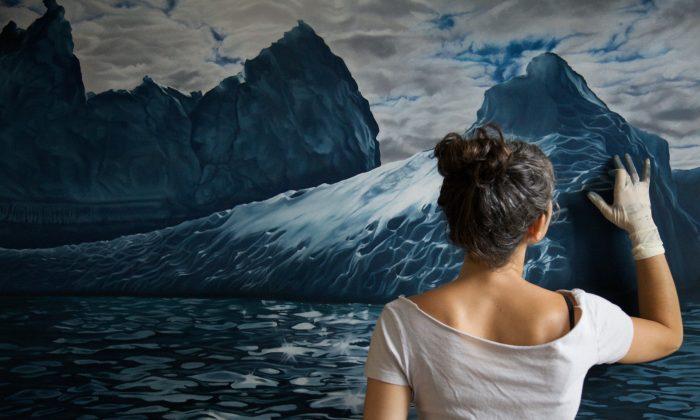NEW YORK—Water is essential, fluid, spiritual, and ephemeral. It bubbles, gurgles, drowns, haunts.
Zaria Forman has experienced and drawn the dense, dark, treacherous waters of the arctic, Israel’s sandy shores, and the dancing droplets of Costa Rica.
Brought up as “a water child” by parents who were swimmers, she and her sister learned to swim at an early age. Scoliosis discovered in childhood made swimming her default physical exercise, and her fascination with water only grew over time.
Most people, when they see one of Forman’s waterscapes, are surprised to discover that it was created in soft pastel. Using solid sticks of pigment to draw a substance that’s colorless, shapeless, and shifting at first seems counterintuitive.
But with a closer look, the tiny granules of colored powder blended to subtle translucency make sense. Pastels, particularly the soft pastels Forman uses, are fragile—the slightest budge can alter them. Watercolors and oils, no matter how thinly applied, are unchangeable once they dry.
On one level, her images of water in their various incarnations—sea, fog, cloud, ice—explore the multifarious manifestations of water. On another, they are a study of impermanence itself.
Finding Peace
On Mother’s Day, 2011, Forman’s mother was diagnosed with brain cancer. The surgery a week later left her almost paralyzed, with limited vision. She was no longer the same person—even her personality was different. She passed away six months later.
Rena Bass Forman was a landscape photographer of remote regions, and every summer since Zaria was 10, the family traveled to a faraway locale.
Forman thought that her traveling days had ended with her mother’s passing but instead turned to it as a way to honor her memory. Last fall, Forman scattered her mother’s ashes during an art expedition she led in Greenland.
“When she passed away, the Greenland trip felt like something I had to do for her because it was her idea,” she said. “I think that particular trip spawned everything else that has happened since.”
On that trip, Forman clarified her artistic vision. She had long been concerned with the environment and global climate change. Greenland 2012 spurred her to make her art about the changing landscape, rising sea levels, and threatened communities.
In this way, mourning her mother and mourning Mother Earth found a parallel.
“Spreading my mother’s ashes while watching the glaciers melt. ... It was incredibly poignant.”
Meditative Work
“Yes, as everyone knows, meditation and water are wedded forever.”
Those are the words of Ishmael in Herman Melville’s “Moby Dick.”
Meditation is precisely how Forman approaches her creative process. During the fall and winter, Forman practically shuts herself up at home, working one- to two-hour chunks all day long.
“While I work, I am focused on the drawing; nothing else exists,” she said. “That is what that meditation is like. Nothing else exists. Although I may not recognize it at the time, that simplicity allows me to process any challenges I might be facing in life.”
Her Brooklyn home and studio are festooned with exotic décor. One area is kept bare save her work-in-progress fastened to a wall and a makeshift stand for her supplies.
Forman works large; larger than most pastel artists dare to work because the medium is so vulnerable and begs for the shelter of glass.
To keep from muddying her colors, Forman works from top to bottom, left to right, applying colors and blending as she goes.
“When I get into the zone, all I see is color, line, and shape.”
To see water’s curvilinear ripples, reflections, and movements brought to life in rich turquoises, moody grays, and heavy indigos, it’s hard not to re-examine this resource we take for granted.
“Water, when you take it out and put it in a cup, is going to look the same anywhere, but [its variations in appearance] has to do with the environment—what’s above it, what’s below it, how the light is reflecting,” she said.
As an integral part of the natural world, water and the issues surrounding it, reflect the state of the environment, and by extension, ourselves.
Beauty in an Uncertain Future
Next month, Forman will journey to the Maldives with painter Lisa Lebofsky and filmmaker Drew Denny. The three hope that by using art, they will create a positive impact on the people there.
The Maldives is an archipelago southwest of India. With its highest atoll (an island formed of coral) only 8 feet above sea level, it is the world’s lowest lying country and the first projected to be swallowed by rising sea levels.
Nearly every place on earth is expected to suffer from changing water patterns. A recent Guardian article cited a report that listed 1,700 places including Sacramento, Calif., and Norfolk, Va., that would be threatened by rising seas and flooding based on a projection of average sea levels.
In the Maldives, Forman and her companions will be exploring that unique ecology and community. Forman hopes to show her artwork to the children there, and that through a discussion about their environment, they will be empowered and inspired to document and appreciate the natural beauty of their homeland, even if in a couple decades the whole country has to relocate.
“I want them to be able to honor it and move on,” Forman said. “It’s sad, but there’s always something born of something dying.”
Zaria Forman’s website is www.zariaforman.com







Friends Read Free